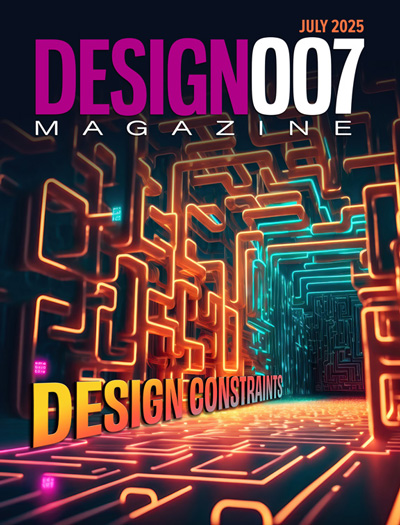-

- News
- Books
Featured Books
- design007 Magazine
Latest Issues
Current Issue
Signal Integrity
If you don’t have signal integrity problems now, you will eventually. This month, our expert contributors share a variety of SI techniques that can help designers avoid ground bounce, crosstalk, parasitic issues, and much more.

Proper Floor Planning
Floor planning decisions can make or break performance, manufacturability, and timelines. This month’s contributors weigh in with their best practices for proper floor planning and specific strategies to get it right.

Showing Some Constraint
A strong design constraint strategy carefully balances a wide range of electrical and manufacturing trade-offs. This month, we explore the key requirements, common challenges, and best practices behind building an effective constraint strategy.
- Articles
- Columns
- Links
- Media kit
||| MENU - design007 Magazine
Sondrel Announces Advanced Modelling Process for AI Chip Designs
September 10, 2024 | SondrelEstimated reading time: 2 minutes
Sondrel, a leading provider of ultra-complex custom chips for leading global technology brands, has announced an Advanced Modelling Process for AI chip designs. This runs through every stage of a chip’s design to ‘prove’ that the design is what was specified – Functional Verification -- and that it does what it is supposed do – Performance Verification.
Paul Martin, Sondrel’s Global Field Engineering Director, explained, “AI chips are extremely complex to design because of the huge amounts of data that have to flow round them between the heterogeneous processors, IO and the memory. There cannot be periods when the processors are stalled waiting for data, which is made more complicated when the chip has several different types of processors each with different data traffic requirements. This new Process enables us to analyse and balance the dataflow through the chip whilst executing the software workloads on the AI chip.
“This uses accurate, cycle-based, system performance modelling early in the design cycle in advance of RTL development, enabling us to check that the design will meet its specification. The Process then continually evolves as RTL and eventually silicon becomes available to validate the design performs as specified. To accelerate the design process, we base the design on our Architecting the Future platform to ensure that we have a reliable, predictable path to market. This means we are reusing pre-verified design elements in the Process that constrain the solution space whilst ensuring high confidence in the integration of those elements, which also reduces risk and time to market.”
Power consumption by AI is a hot topic with some predictions saying that the power consumption of data centres could as much as triple the world’s energy needs. With AI proliferating everywhere to make devices smarter, there is an obvious drive to process data as much as possible before sending it to the cloud – so called AI at the Edge. To do this efficiently means that the power consumption of these compute intensive chips must be minimised which means using advanced nodes to hit the targets. Sondrel has always specialised in designing at the leading edge of chip technology and is currently working on 3nm designs. Advanced process technologies enable the power usage to be constrained whilst delivering the performance from using billions of transistors required from these ultra-complex custom chips.
A key to the Process is that it is able to extract the behavioural interaction between the processors and the memory and then map it onto the rest of the chip’s functions. This insight enables Sondrel’s designers to see how the chip is performing and to optimise the design to achieve the required balance of Power, Performance and Area.
Testimonial
"Advertising in PCB007 Magazine has been a great way to showcase our bare board testers to the right audience. The I-Connect007 team makes the process smooth and professional. We’re proud to be featured in such a trusted publication."
Klaus Koziol - atgSuggested Items
Deca, Silicon Storage Technology Announce Strategic Collaboration to Enable NVM Chiplet Solutions
09/11/2025 | Microchip Technology Inc.As traditional monolithic chip designs grow in complexity and increase in cost, the interest and adoption of chiplet technology in the semiconductor industry also increases.
I-Connect007 Launches New Podcast Series on Ultra High Density Interconnect (UHDI)
09/10/2025 | I-Connect007I-Connect007 is excited to announce the debut of its latest podcast series, which shines a spotlight on one of the most important emerging innovations in electronics manufacturing: Ultra-High-Density Interconnect (UHDI). The series kicks off with Episode One, “Ultra HDI: What does it mean to people? Why would they want it?” Host Nolan Johnson is joined by guest expert John Johnson, Director of Quality and Advanced Technology at American Standard Circuits (ASC).
Global Citizenship: Together for a Perfect PCB Solution
09/10/2025 | Tom Yang -- Column: Global CitizenshipIf there’s one thing we’ve learned in the past few decades of electronics evolution, it’s that no region has a monopoly on excellence. Whether it’s materials science breakthroughs in Europe, manufacturing efficiencies in China, or design innovations in Silicon Valley, the PCB industry thrives on collaboration.
The Shaughnessy Report: Winning the Signal Integrity Battle
09/09/2025 | Andy Shaughnessy -- Column: The Shaughnessy ReportWhen I first started covering this industry in 1999, signal integrity was the hip new thing in PCB design. Conference classes on signal integrity were packed to the walls, and an SI article was guaranteed to get a lot of reads.
The Signal Integrity Issue: Design007 Magazine September 2025
09/09/2025 | I-Connect007 Editorial TeamAs the saying goes, “If you don’t have signal integrity problems now, you will eventually.” This month, our experts share a variety of design techniques that can help PCB designers and design engineers achieve signal integrity.


